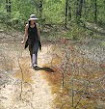Eastern North America Deciduous Forest Region / Carolinian Life Zone
-Mixedwood Plains Ecozone
--Lake Erie Lake Ontario Ecoregion 7E, aka "Carolinian Canada"
---your Conservation Authority
----your watershed (in Toronto and area)
-----Subwatershed (in the Don)

From the OMNR’s Ecological Landscape Primer:
"Southern Ontario’s Mixedwood Plains Ecozone
Ontario’s southernmost ecozone, occupying less than 10% of the province, is defined by the limestone and dolostone bedrock that occurs south of the Precambrian Shield. This ecozone is bounded in the south and west by Lake Huron, Lake Erie, Lake Ontario and the St. Lawrence River. The predominant type of natural disturbance in forest ecosystems is gap-phase dynamics, although major wind events and insect outbreaks can cause more extensive disturbance. In wetland systems, beavers are a major force of change. Vegetation is diverse, despite the conversion of many natural lands for agriculture and urban development. Mixed forests of deciduous and coniferous trees occur, as well as areas dominated by deciduous tree species as in Carolinian forests. Two globally imperilled ecosystems occur in the ecozone: tallgrass prairie and limestone barrens called ‘alvars’. Wetlands are numerous in certain areas, although many have been drained. Plants and wildlife in this ecozone are among the most diverse in Canada, but they face significant challenges due, in large part, to habitat loss and fragmentation. ...Alien invasive species are an increasing threat to native species in this ecozone.
Mixedwood Plains Ecozone: Lake Erie - Lake Ontario Ecoregion (7E)
Bounded by the southern Great Lakes, the Lake Erie-Lake Ontario Ecoregion, also called the Carolinian Forest Ecoregion, is the southernmost ecoregion in the province. The limestone bedrock in this ecoregion is rarely exposed except along the southern portion of the Niagara Escarpment. Rather, till plains and deep, fine grained sediments from glacial and post-glacial lakes blanket the sedimentary bedrock, imparting a very flat relief to much of the ecoregion. Wetlands and water are found on less than 2% of the ecoregion. The Lake Erie-Lake Ontario Ecoregion is contained within the Deciduous Forest Region and has the greatest diversity of species in Canada. It is estimated that almost 400 bird species, 2,200 species of herbaceous plants and 70 species of trees are found here. Distinctive Carolinian tree species include Tulip Tree, Sycamore, Kentucky Coffeetree, and the endangered Cucumber Tree and Butternut. The ecoregion also supports the most extensive remnants of tall grass prairie vegetation in the province. The animal species in this ecoregion include many that are at risk or provincially rare, including Spiny Softshell Turtle, Smallmouth Salamander, Karner Blue butterfly, American Badger and Acadian Flycatcher. The area is the province's most developed ecological region, with 78% and 7% of the land area converted to agriculture and to sub/urban land-uses, respectively."
*
Carolinian Life Zone - from
The Ruthven Park Nature Blog - Carolinian Forest Fact Sheet"The “Life Zone” concept was developed in 1889 by C. Hart Merriam, an American zoologist and a founder of the US National Geographic Society, as a means of describing areas with similar plant and animal communities.
The Carolinian Life Zone is centred in the Carolinas in the United States and is found in Canada only in the southwestern section of Ontario.
Carolinian forest is characterized by a predominance of deciduous, or broad-leafed, tree species.
Although only approximately 1% of Canada falls within the Carolinian Life Zone, more species of plants and animals are found here than anywhere else in Canada. Over 2200 species of plants are found within the Carolinian zone in Canada."
*
We're Canada's bio-diversity "hot spot" but we also have the challenge of more rare / species-at-risk than anywhere else in Canada.



No comments:
Post a Comment